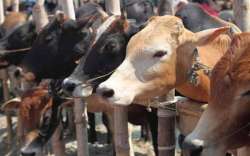Humble cow to be largest remaining mammal in 200 years: Study
"It wasn't until human impacts started becoming a factor that large body sizes made mammals more vulnerable to extinction," said study co-author Kate Lyons from University of Nebraska-Lincoln in the US.

The pace at which humans have been hunting down large mammals into extinction since the early ages, the largest remaining mammal in 200 years would be the domestic cow, warn researchers.
"It wasn't until human impacts started becoming a factor that large body sizes made mammals more vulnerable to extinction," said study co-author Kate Lyons from University of Nebraska-Lincoln in the US.
"The anthropological record indicates that Homo sapiens are identified as a species around 200,000 years ago, so this occurred not very long after the birth of us as a species. It just seems to be something that we do," Lyons said.
"From a life-history standpoint, it makes some sense. If you kill a rabbit, you're going to feed your family for a night. If you can kill a large mammal, you're going to feed your village," Lyons added.
By contrast, the research team found little support for the idea that climate change drove extinctions during the last 66 million years.
Large and small mammals seemed equally vulnerable to temperature shifts throughout that span, the authors said.
The study, published in the journal Science, showed that ancient humans might have begun hunting large mammal species down to size -- by way of extinction -- at least 90,000 years earlier than previously thought.
Elephant-dwarfing wooly mammoths, elephant-sized ground sloths and various saber-toothed cats highlighted the array of massive mammals roaming Earth between 2.6 million and 12,000 years ago.
Prior research suggested that such large mammals began disappearing faster than their smaller counterparts -- a phenomenon known as size-biased extinction -- in Australia around 35,000 years ago.
With the help of emerging data from older fossil and rock records, the new study estimated that this size-biased extinction started at least 125,000 years ago in Africa.
By that point, the average African mammal was already 50 per cent smaller than those on other continents, the study reported, despite the fact that larger landmasses can typically support larger mammals.
But as humans migrated out of Africa, other size-biased extinctions began occurring in regions and on timelines that coincide with known human migration patterns, the researchers found.
Over time, the average body size of mammals on those other continents approached and then fell well below Africa's.
Mammals that survived during the span were generally far smaller than those that went extinct.
The magnitude and scale of the recent size-biased extinction surpassed any other recorded during the last 66 million years, according to the study.
"What we're doing is potentially erasing 40 to 45 million years of mammal body-size evolution in a very short period of time," Lyons said.
"Ecosystems are going to be very, very different in the future. The last time mammal communities looked like that and had a mean body size that small was after the extinction of the dinosaurs," Lyons said.